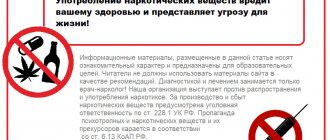PREDNISOONE BUFUS
Interaction
There may be pharmaceutical incompatibility of prednisolone with other intravenously administered drugs; it is recommended to administer it separately from other drugs (intravenous bolus, or through another dropper, as a second solution).
When mixing a solution of prednisolone with heparin, a precipitate forms. Simultaneous administration of prednisolone with:
- inducers of microsomal liver enzymes (phenobarbital, rifampicin, phenytoin, theophylline, ephedrine) leads to a decrease in its concentration;
- diuretics (especially thiazide and carbonic anhydrase inhibitors) and amphotericin B - can lead to increased excretion of potassium ions (K+) from the body and an increased risk of developing heart failure;
- with sodium-containing drugs - to the development of edema and increased blood pressure;
- cardiac glycosides worsen their tolerability and increase the likelihood of developing ventricular extrasytolia (due to hypokalemia);
- indirect anticoagulants - weakens (less often enhances) their effect (dosage adjustment required);
- anticoagulants and thrombolytics - increases the risk of bleeding from ulcers in the gastrointestinal tract;
- ethanol and nonsteroidal anti-inflammatory drugs (NSAIDs) - increases the risk of erosive and ulcerative lesions in the gastrointestinal tract and the development of bleeding (in combination with NSAIDs in the treatment of arthritis, it is possible to reduce the dose of glucocorticosteroids due to the summation of the therapeutic effect);
- paracetamol - the risk of developing hepatotoxicity increases (induction of liver enzymes and the formation of a toxic metabolite of paracetamol);
- acetylsalicylic acid - accelerates its elimination and reduces its concentration in the blood (when prednisolone is discontinued, the level of salicylates in the blood increases and the risk of side effects increases);
- insulin and oral hypoglycemic drugs, antihypertensive drugs - their effectiveness decreases;
- vitamin D - its effect on the absorption of calcium ions (Ca2+) in the intestine is reduced;
- growth hormone - reduces the effectiveness of the latter, and with praziquantel - its concentration;
- M-anticholinergics (including antihistamines and tricyclic antidepressants) and nitrates - helps increase intraocular pressure;
- isoniazid and mexiletine - increases their metabolism (especially in “fast acetylators”), which leads to a decrease in their plasma concentrations.
Carbonic anhydrase inhibitors and loop diuretics may increase the risk of osteoporosis.
Indomethacin, displacing prednisolone from its connection with albumin, increases the risk of developing its side effects.
Adrenocorticotropic hormone enhances the effect of prednisolone.
Ergocalciferol and parathyroid hormone prevent the development of osteopathy caused by prednisolone.
Cyclosporine and ketoconazole, by slowing down the metabolism of prednisolone, can in some cases increase its toxicity.
The simultaneous use of androgens and steroidal anabolic drugs with prednisone contributes to the development of peripheral edema and hirsutism, and the appearance of acne. Estrogens and oral estrogen-containing contraceptives reduce the clearance of prednisolone, which may be accompanied by an increase in the severity of its action.
Mitotane and other inhibitors of adrenal function may necessitate an increase in the dose of prednisolone.
When used simultaneously with live antiviral vaccines and against the background of other types of immunizations, it increases the risk of viral activation and the development of infections.
Antipsychotics (neuroleptics) and azathioprine increase the risk of developing cataracts when prednisolone is prescribed.
When used simultaneously with antithyroid drugs, the clearance of prednisolone decreases and with thyroid hormones increases.
Prednisolone-induced hypokalemia may increase the severity and duration of muscle blockade caused by muscle relaxants.
Immunosuppressants increase the risk of developing injections and lymphoma or other lymphoproliferative disorders caused by the Epstein-Barr virus.
Tricyclic antidepressants may increase the severity of depression caused by taking prednisolone (not indicated for the treatment of these side effects).
Prednisolone
Prednisolone is a synthetic glucocorticosteroid drug, a dehydrogenated analogue of hydrocortisone. It has anti-inflammatory, anti-allergic, immunosuppressive, anti-shock effects, increases the sensitivity of beta-adrenergic receptors to endogenous catecholamines.
Interacts with cytoplasmic receptors of glucocorticosteroids (GCS) to form a complex that induces the formation of proteins (including enzymes that regulate vital processes in cells).
Anti-inflammatory effect
associated with inhibition of the release of inflammatory mediators by eosinophils and mast cells; inducing the formation of lipocortins and reducing the number of mast cells that produce hyaluronic acid; with a decrease in capillary permeability, stabilization of cell membranes and organelle membranes (especially lysosomal ones). Acts on all stages of the inflammatory process: inhibits the synthesis of prostaglandins at the level of arachidonic acid (lipocortin inhibits phospholipase A2, suppresses the release of arachidonic acid and inhibits the biosynthesis of endoperoxides, leukotrienes, which contribute to inflammation, allergies, etc.); synthesis of “pro-inflammatory cytokines” (interleukin-1, tumor necrosis factor alpha, etc.); increases the resistance of cell membranes to the action of various damaging factors.
Immunosuppressive effect
caused by involution of lymphoid tissue, inhibition of the proliferation of lymphocytes (especially T-lymphocytes), suppression of the migration of B-lymphocytes and the interaction of T- and B-lymphocytes, inhibition of the release of cytokines (interleukin-1 and interleukin-2; interferon gamma) from lymphocytes and macrophages and decreased antibody formation.
Antiallergic effect
develops as a result of a decrease in the synthesis and secretion of allergy mediators, inhibition of the release of histamine and other biologically active substances from sensitized mast cells and basophils, a decrease in the number of circulating basophils, suppression of the development of lymphoid and connective tissue, a decrease in the number of T- and B-lymphocytes, mast cells, reducing the sensitivity of effector cells to allergy mediators, suppressing antibody formation, changing the body's immune response.
For obstructive airway diseases
the effect is due mainly to inhibition of inflammatory processes, prevention or reduction of the severity of edema of the bronchial mucous membranes, reduction of eosinophilic infiltration of the submucosal layer of the bronchial epithelium and deposition of circulating immune complexes in the bronchial mucosa, as well as inhibition of erosion and desquamation of the mucous membrane. Increases the sensitivity of beta-adrenergic receptors of small and medium-sized bronchi to endogenous catecholamines and exogenous sympathomimetics, reduces the viscosity of mucus by reducing its production.
Suppresses the synthesis and secretion of adrenocorticotropic hormone (ACTH) and, secondarily, the synthesis of endogenous corticosteroids.
Inhibits connective tissue reactions during the inflammatory process and reduces the possibility of scar tissue formation.
Instructions for use of Prednisolone in ampoules
Injections are given in 3 ways - into a vein, muscle or joint. The dosage, frequency and duration of administration are determined by the attending physician. The instructions depend on the age and condition of the patient. Most often, injections are given intravenously.
In this case, they start with small doses, which are calculated in connection with body weight:
- children from 2 to 12 months – 2-3 mg per 1 kg of weight;
- children from 1 year to 14 years inclusive – 1-2 mg per 1 kg of weight;
- adults – 1-2 g of active substance per person;
- in critical conditions, adults are given ultra-high doses.
Composition, release form
The active component of Prednisolone is the substance of the same name, presented in the form of sodium phosphate (30 mg per 1 ml). The product is available in 3 forms:
- Pills.
- Ampoules with solution for injection.
- Ointment.
- Eye drops.
Along with the active ingredient, the drug contains magnesium stearate, starch, colloidal silicon dioxide, disodium edetate and other auxiliary components.
The drug belongs to the group of corticosteroids of low activity (group I). The drug is aimed at blocking allergic reactions by suppressing the immune response. It has anti-inflammatory and anti-shock effects.
Prednisolone can only be purchased with a prescription. It can be stored at moderate temperatures (not higher than 25 degrees). The general shelf life is 3 years for eye drops, for other forms of release - 2 years from the date of production. After opening the bottle of eye drops, the product must be used within 4 weeks.
What Prednisolone is used for: indications for use
The product is indicated for use in various diseases. Directions for use depend on the form of release. So, injection solution and tablets are used in case of such disorders and diseases:
- multiple sclerosis;
- lungs' cancer;
- chorea;
- allergic diseases of various nature;
- fibrosis;
- acute alveolitis;
- bronchial asthma;
- rheumatic heart disease;
- hypocortisolism (primary and secondary);
- dysfunction of the adrenal cortex, including congenital dysfunction;
- autoimmune diseases;
- excess calcium associated with cancer;
- nephrotic syndrome;
- in case of rejection of transplanted organs after surgery;
- inflammation of the digestive system, etc.
Prednisolone is also used in emergency cases. For example, injections and tablets are used to relieve food-related allergy attacks, as well as to relieve anaphylactic shock.
The ointment is used externally to treat skin diseases:
- eczema;
- limited neurodermatitis;
- dermatitis of various nature;
- hives;
- lupus erythematosus;
- erythroderma;
- eczema;
- toxicoderma.
Drops are used to treat eye diseases:
- uveitis;
- blepharitis;
- sympathetic ophthalmia;
- iridocyclitis;
- allergic conjunctivitis;
- scleritis;
- iritis;
- episcleritis;
- blepharoconjunctivitis, etc.
Contraindications for use
There is a fairly large list of contraindications to the use of the product. The most extensive list is related to the ban on the use of injection solution and tablets. They cannot be used in the presence of the following pathologies:
- individual intolerance;
- tuberculosis, mycosis and other infectious pathologies;
- myocardial infarction (if it was recently suffered);
- hyperlipidemia;
- immunodeficiency, including those associated with HIV;
- diseases of the digestive system (including ulcerative lesions, diverticulitis);
- period after the vaccine (you need to wait at least 2 months before and 2 weeks after);
- severe renal or liver failure;
- thyroid disorders;
- diabetes;
- acute psychosis;
- urolithiasis;
- systemic osteoporosis;
- severe obesity (starting from stage 3);
- myasthenia gravis;
- polio;
- closed-angle and open-angle glaucoma;
- lymphadenitis, aggravated after the BCG vaccination;
- pregnancy and lactation at any stage.
Giving an injection intra-articularly is not allowed in the presence of the following pathologies:
- systemic infection;
- dry joint syndrome;
- severe joint deformities;
- necrosis of the epiphysis of the bone;
- pyogenic arthritis;
- systemic infections;
- joint instability due to arthritis;
- bleeding of a pathological nature;
- pregnancy period (any trimester).
The use of ointment is contraindicated if you have:
- tumors;
- tuberculosis;
- acne;
- mycosis;
- syphilis (if it manifests itself, including on the skin);
- during pregnancy (any trimester).
Eye drops should not be taken if the following disorders are diagnosed:
- damage to the organ of vision of a fungal or viral nature;
- infection of the eyelid, mucous membrane;
- purulent corneal ulcer;
- complications after removal of a foreign body from the eye.

